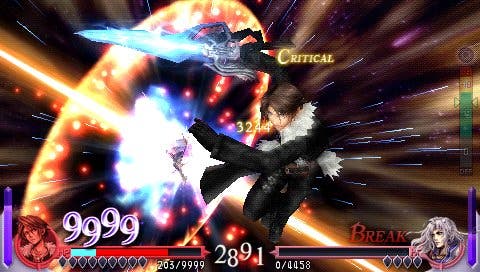Dissidia: Final Fantasy
Final Fantasy meets Final Fight... Finally!
Hands up anyone who thought Square Enix would ever release a fighting game made up completely of Final Fantasy characters? Okay, so maybe the DreamFactory-developed Ehrgeiz hinted at it, but I honestly didn't see this coming. Dissidia offers players the chance to fight as either the lead hero or villain from Final Fantasy I through to Final Fantasy X, in full real-time bouts a million miles away from the series' turn-based staple. Time to see whether Squall's Gunblade mastery really is a match for the Buster Sword-wielding Cloud.
Unlike the original Super Smash Bros. excuse of "they're fighting dolls", Dissidia's explanation for the Final Fantasy cast being in the same universe is more sinister. Chaos, the god of discord, and Cosmos, the god of harmony, have been fighting for an eternity within the Dissidia universe. In a bid to destroy Cosmos, Chaos sneakily imports all his favourite antagonists from the Final Fantasy games - with the dark army they subsequently build tipping the balance greatly in his favour. With no option left but to rip off Chaos's idea, Cosmos retaliates by summoning all the manically depressed protagonists from the same games in order to settle the score once and for all.
Rather than the face-to-face fighting style of Tekken and Street Fighter, bouts in Dissidia take place in open 3D arenas similar to Power Stone - but without all the Flamethrowers and Hammers. Players can lock on and off their opponent with the left trigger and run across the arena with the analogue stick. The four face buttons are allocated to Brave attack, HP attack, jump and context-sensitive environment manoeuvres, which might make more sense in Tony Hawk's, but basically deals with all your wall-running and ledge-grinding.
The right trigger, meanwhile, is your obligatory Guard, but as a guard state can't be held it works in effect more like a parry. Guard can also be used with the face buttons for more advanced moves. Guard and jump will execute a dodge manoeuvre which, if timed correctly, will allow you to completely evade an enemy attack for a swift counter.

Unlike most conventional fighters, Dissidia's Brave and HP attack system offers a genuinely fresh approach for KO enthusiasts. Each combatant begins a fight with a certain amount of BP (Brave Points) - indicated by a number above the health bar. By performing Brave attacks the player can steal BP from the enemy's gauge and add it to their own. Also, if through sustained Brave attacks the player brings the opponents BP total to zero, they will send the opponent into Break status and receive a massive BP bonus.
The point of accumulating all this BP is the HP attack. The amount of damage dealt by a HP attack is equal to the player's pooled Brave Points - with a successful hit resetting the attacking player's BP to zero for a short time. This lends Dissidia a very tactical style of play because a full health bar is meaningless if your opponent's BP is in the high thousands.
Working in tandem to the BP system is the EX gauge (you weren't expecting a Final Fantasy fighter to be simple, were you?). Your opponent will drop tiny EX orbs if you combo them through chained attacks which, when collected, will slightly increase your EX total. EX cores will provide a more dramatic boost and spawn in various locations across the arenas. Once the EX gauge is maxed your character will be able to enter EX mode for a short time.
In EX mode Cloud will ditch his rusty old Buster Sword and replace it with Ultima Weapon, gaining the rather annoying ability to Guard Crush (rendering guards useless). Tina's take on EX is turning into her naked Esper form, complete with the ability to combo her magic attacks and glide. Other highlights include Jecht's transformation into Final Aeon and Golbeza's summoning of the Shadow Dragon. In EX mode around half the characters will also slowly regain their lost health, Regen style.

Fleeing from a similarly skilled opponent who's achieved EX is often a sound strategy, as the worst thing you can let them do is land an HP attack. Connecting a HP attack while in EX Mode will launch your character's ultimate EX burst attack. These work similarly to the Limit Breaks in Final Fantasy VII (or if you want to be pedantic, perhaps even the Desperation Moves from Final Fantasy VI) and require a short quick-time sequence to successfully charge - i.e. mashing circle, matching displayed inputs, etc. The mayhem that ensues after a successful EX burst is all kinds of Omnislash over-the-top. Exdeath uses the power of the Void to crush his opponent in a gravity field and Sephiroth hurls his hapless victim into a Supernova. Basically, if you manage to land a perfect EX burst on your opponent with a ruinously high BP total, it's quite likely you've just won the match.
Dissidia's graphical presentation is in stark contrast to the gritty Crisis Core and has more of a Kingdom Hearts feel (hardly surprising with Tetsuya Nomura onboard). The arenas draw upon the previous Final Fantasy games and include the Crystal World from FFIX and the Magitek Research Facility from FFVI. All have a certain vibrancy which, despite their relative lack of destructible architecture, helps personify the titled Fantasy appeal.


